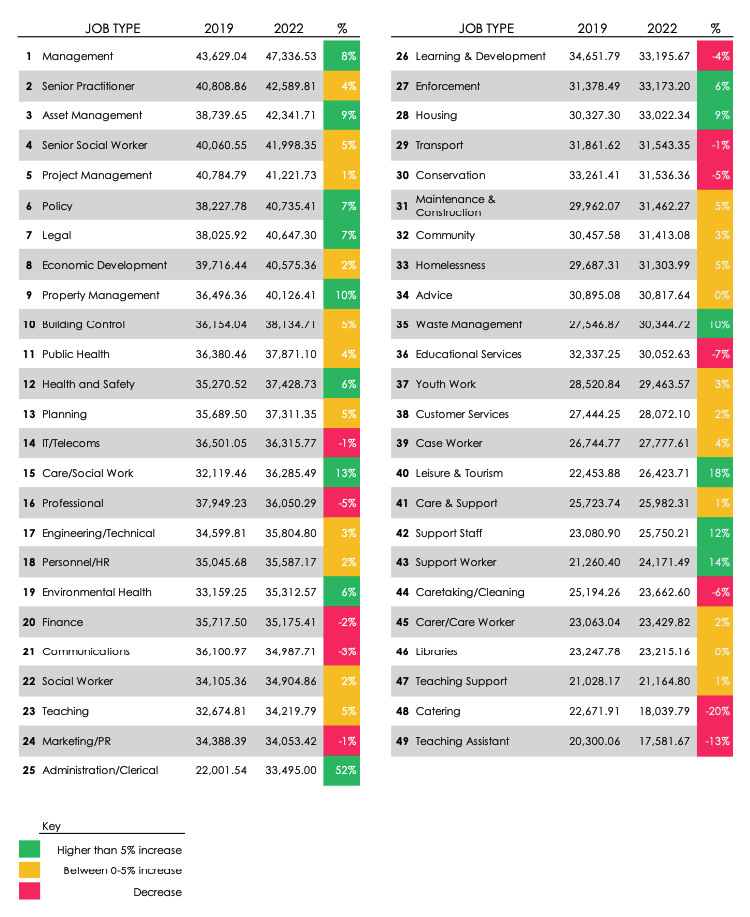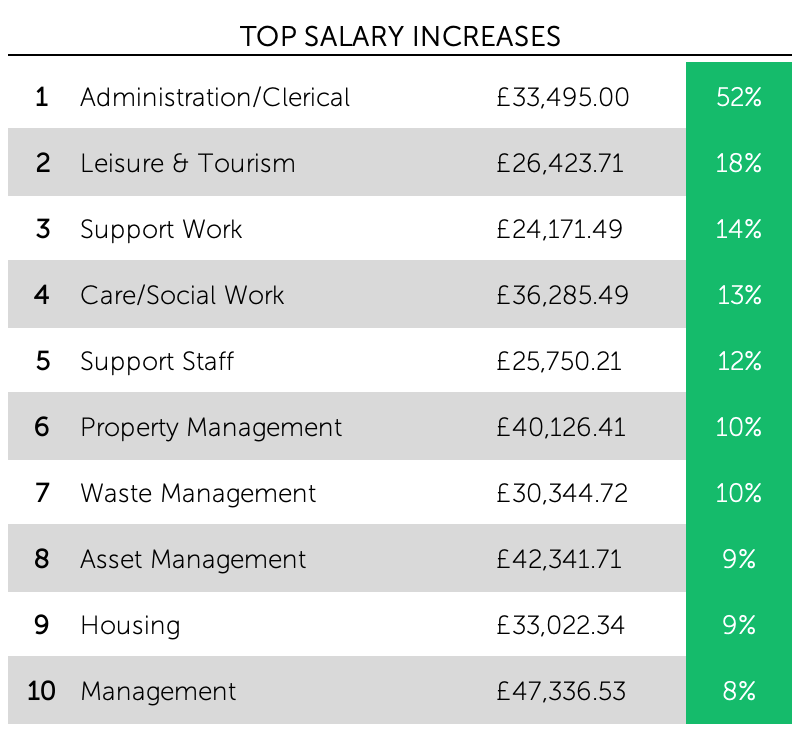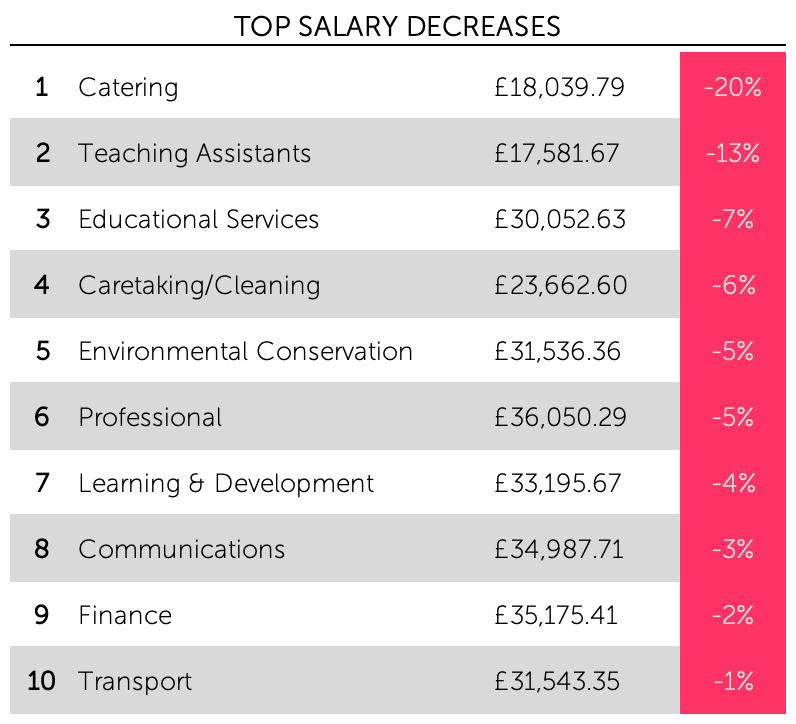
Public sector pay trends: A post-pandemic analysis
Foreword from the founder of Jobs Go Public
For almost 25 years, Jobs Go Public has provided innovative recruitment services to public sector organisations, including candidate sourcing, consultancy support, recruitment technology, and vacancy advertising.
Our latest ‘Public sector pay trends’ report, which analyses 100,900 job vacancies across 49 job types since 2019, is an example of the benchmarking data we provide for hiring managers to make decisions around pay and benefits alongside their recruitment strategies.
Hiring is a key challenge for any organisation, but it has been especially difficult within the public sector. Managers contend with funding decisions and media narratives which can deter candidates from pursuing a career in the sector, and the pandemic exacerbated underlying skill shortages. Many public sector leaders have struggled to run services at full capacity.
Employees have been working more hours to try and plug the gap. Frontline workers increased their hours to such an extent during the pandemic that weekly earnings in the public sector actually rose by 4.1% amidst a 253% increase in redundancy rates in 2020.
The public sector is no longer in the full grip of COVID-19, but workforce challenges continue to put pressure on UK public services. This report aims to help hiring managers make competitive offers to candidates and employees. Jobs Go Public is here to support, with our end-to-end resourcing solutions that are tailored to challenges in the public sector.
David Marshall
Founder, Jobs Go Public
Introduction and key findings
Large political and economic challenges caused by COVID-19 have affected pay. This makes it more complicated for employers to manage salaries. Local government faces a particular challenge because it competes with the more agile private sector.
With the UK’s public sector experiencing major skills and retention challenges, salary is a crucial element of Employee Value Proposition. This data will help business leaders and hiring managers hire and keep skilled public sector staff who provide high-quality services to their communities.
The aim of this report is to provide an overview of how salaries have changed during the pandemic. We will explore how factors such as COVID-19 have affected different job types across the sector. We will also examine:
- The current economic landscape
- The state of public sector recruitment
- Public sector challenges
- Demand for roles
- Shifts in average salary
Please note our report is based on salary packages posted on jobsgopublic.com, and does not account for inflation. In real terms, weekly earnings for public sector staff have decreased by 4.3% over the last decade.
41%
52%
3/4

Methodology
The trends this report identifies are based on vacancies our clients posted on jobsgopublic.com between 2019 and 2022. This sample includes 100,941 roles which were posted by or on behalf of our clients.
Our data sample was cleaned to ensure consistency, with free text salary fields reformatted as pay bands. We also created a new field in our data from the midpoint of each job’s pay band.
We then segregated the data by job types. We chose to analyse job types which had a sample of at least 500 vacancies between 2019 and 2022. Averages for each job type per year were based on the midpoint of the salary band. Finally, we compared the percentage difference of these averages to track changes over the pandemic.
It is important to note the limitations of this data.
The results of this report are based on a sample from jobsgopublic.com and provide a snapshot of the sector. External factors such as experience requirements and skills may also have influenced results. Moreover, our data is an exploration of trends in gross pay packages which are not adjusted for inflation.
COVID-19’s impact on the public sector
The last four years are of note because of the COVID-19 pandemic’s consequent impact. In 2020, the UK economy suffered a significant downturn.
Gross Domestic Product (GDP) dropped by 10%, producing a parallel drop in tax revenue of 11% between 2020-21.
Meanwhile, the pandemic forced the government to increase spending. Around 1 in 4 employees were furloughed on the Coronavirus Job Retention Scheme (CJRS). This scheme protected 11.7 million jobs and cost a total of £70 billion.
Additionally, emergency services such as PPE, contact tracing, and vaccines cost the public sector £127 billion. As a result, government spending rose to 54% of the country’s GDP, compared to 40% in the year before the pandemic
This economic crash led to a 253% increase in redundancy rates in 2020, creating downward pressure on wages. Despite this, weekly public sector earnings rose by 4.1%. The House of Commons Library suggests this is because of increased hours for frontline workers such as healthcare professionals.
Regardless of this, central government froze public sector wages in 2020/21 due to the pandemic’s impact on the private sector. This caused wage growth to slow down to 1.5% for a year.
However, the decision was reversed in the 2021 Spending Review. By April 2022, full-time public sector workers were earning approximately £695 a week, compared to £620 for the private sector.
As can be seen, COVID-19 created a complex relationship between the economy, government policy, and the public sector. This impacted people’s livelihoods as we headed into a cost-of-living crisis towards the end of 2022.
Yet, forecasts suggest the lasting effect of COVID-19 will not be as severe as the 2008 financial crash.
Public sector recruitment landscape
Local government funding challenges
Before exploring our job board data, it is worth understanding some of the wider challenges the UK public sector is facing.
Local government spending power dropped by 16% in the last decade, due to grant cuts from central government. This financial pressure has forced local government to make cuts to services such as:
- Planning and Development – Economic development, environmental initiatives, and Building Control.
- Housing – Community support, housing renewal, homelessness administration, and welfare services.
- Highways and Transport – Traffic management, transport planning, road maintenance, and public transport.
- Environmental – Community safety, regulatory services, and waste management.
The funding issue has only worsened due to recent inflation. The County Councils Network (CCN) forecasts a council revenue pressure of around £1.8 billion in the next financial year.
The result is that councils will be forced to further reduce services such as Children’s Social Work and Social Care.
Staff retention and skills shortages
Funding issues have put increased pressure on staff retention. ONS data shows that between 2019 and 2022 the number of staff in local government decreased by 3%.
Higher workloads due to service cuts and staff turnover is likely to put further pressure on current staff and their wellbeing. Last year, a Trades Union Congress (TUC) analysis showed that 45% of key workers were thinking of quitting due to government pay policy. In addition, a third of public sector staff stated they had already begun to leave their jobs or were actively considering it.
For employees taking these steps, they gave the TUC reasons such as:
- Low pay (52%)
- Feeling undervalued (47%)
- Poor work-life balance (33%)
- Excessive workload (31%)
As staff turnover increases, in part because of low morale, it is likely that staff shortages will get worse.
Public sector recruitment isn’t slowing
Because of the UK’s skills shortage there is a great demand for workers. Overall, employers across the country posted 43% more vacancies in 2022 than in 2019.
Figure 5.1 below shows the number of vacancies posted in the UK by subsector in 2019 and 2022. It demonstrates a marked increase in public sector industries such as Education (46%) and Health & Social Work (49%).

In 2021, three in five recruiters noted they had 30% more vacancies to fill than before the pandemic. 73% of health and social care staff are reluctant to change jobs, creating even more demand for local authorities.
- Social Work
- Planning
- Care Work
- Legal
Although just under half of councils are offering a market supplement for Children’s Social Work, the supplement offer drops to just 2% of councils for most other job types.
Brexit has also created its own unique set of challenges. In 2017, the Scottish government estimated that 5.6% of the UK’s social care and childcare workforce were EU nationals.
Yet, it is now more difficult for EU citizens to work in the UK, reducing the pool of skilled candidates. In fact, 46% of recruiters report difficulty filling vacancies due to new EU immigration laws.
What are your current hiring needs?

What is our data telling us?
Salary shifts by job type
Figures 6.1 (see right) shows how average salaries have changed by job type since 2019. The data includes 49 job types from jobsgopublic.com which met the requirements for sample sizes. These job types are sorted by order of salary in 2022, starting from highest average salary.
This data provides a benchmark for the average expected salary in the UK for public sector directorates.
Download the full public sector pay trends league table
Three quarters of job types experienced an increase in gross pay post-pandemic. This is regardless of which pay bracket the average salary fell into.
Figure 6.2 - Top salary increases

Figure 6.2 shows that Administration/Clerical salaries have increased by an average of 52%. In contrast, salaries for Catering staff have decreased by a fifth over the pandemic (see figure 6.3 on the right). These are perhaps areas which require a more demanding skill set.
It is also interesting that despite funding cuts, salaries in Care/Social Work, Waste Management, and Housing have all increased.
Figure 6.3 - Top salary decreases

As noted earlier in the report, recruiters are struggling to recruit care and social workers, requiring more incentive for prospective staff who are reluctant to change jobs.
Conversely, Transport does not appear to have experienced the same phenomenon as these service areas, with salaries dropping by 1%.
Employee demand on our jobs board
Looking at employee demand it becomes less surprising that around 75% of job roles experienced an average salary increase.
For the 20 role types explored, there were 15,986 vacancies in 2019, and 22,585 vacancies in 2022. This shows an increase in job postings on jobsgopublic.com of 41% after the pandemic. Interestingly, this trend is almost the same as the national cross-sector increase noted by the ONS as discussed earlier in the report.
The most noteworthy correlation between increased salary and demand was seen with Support Staff. In this job type, the number of vacancies almost trebled in 4 years.
Administration/Clerical roles almost doubled, while Leisure & Tourism saw an increase of two thirds. This could provide an explanation as to why these jobs’ average salary offering increased, particularly for Administration/Clerical where salaries shot up by 52%.
Therefore, it could be possible that an overall increase in demand for skilled employees has created upward pressure for salaries.
However, not all vacancies which saw increases also had more vacancies live in 2022. For instance, Property Management roles decreased by 59.4% despite a 10% salary increase.
In these cases, it is likely that local authorities require more experienced candidates. In directorates such as Housing which experienced cuts, there may be more pressure for less staff to continue providing high-quality services.
Figure 6.4 - Number of vacancies posted on jobsgopublic.com by job types which experienced large salary increases

The picture looks rather less clear-cut for the job types whose salaries decreased over the pandemic.
It may be possible to conclude that salaries decreased in areas such as Environmental Conservation and Finance due to lower demand for staff. However, many of these job areas saw a huge increase in job postings after the pandemic.
For example, job postings for Catering staff increased by seven times despite a massive average salary drop of 20%. One possible explanation for this is that Catering staff for employers such as schools were not in demand during the pandemic as children learned at home.
Figure 6.5 - Number of vacancies posted on jobsgopublic.com for roles which experienced salary decreases over the pandemic

As schools reopened the need to fill the vacancies caused by the pandemic would have been huge. Salaries may have decreased at the same time due to taking on less experienced candidates to fill this massive demand.
As can be seen from figures 6.4 and 6.5, it is not possible to conclude that there is a direct correlation between candidate supply, demand, and salary. When considering the wider market landscape as explored earlier, there is a complex interweaving of factors that affect salary packages.
How to use this data to shape your people strategy
/IMG_8825_web_ready.jpg?width=1859&height=1240&name=IMG_8825_web_ready.jpg)
Despite the challenges brought on by the pandemic and other political events, gross pay for most job types has increased since the pandemic. However, it is important to remember that in real terms, inflation has diluted the effect of these pay increases.
With a benchmark of the average expected salary for these job types, employers can use this data to make informed decisions. This is increasingly important in a competitive job market for talent attraction and fostering great employee experience.
It is also worth noting the limitations of the data sample, which is based on a snapshot of the sector and may be influenced by external factors such as experience requirements and skills.
We understand that with the funding challenges the local government faces, setting competitive salaries can be difficult. It is important to consider other factors which can allow you to overcome skills shortages in a saturated job market. For example, you should create a positive work culture that values diversity, inclusion, and employee well-being.
You can achieve this by promoting open communication, providing opportunities for growth and development, recognising employee achievements, and offering flexible work arrangements.
Moreover, jobseekers are also looking at benefits as a way of coping with the cost of living. Research from the Chartered Institute of Personnel and Development demonstrates that the public sector is more likely to offer benefits such as:
- Pension schemes (90% of employers)
- Discounts (71%)
- Insurance (45%)
- Living wage (65%).
Make sure you are highlighting your benefits packages in your job adverts and careers pages, especially those which may supplement living cost issues. For more advice on creating an age positive workplace which meets the values of your employees, check out our article on hiring over 50s.
It’s also important to prioritise mental health and wellbeing, and ensure that employees have access to resources and support when needed. Additionally, you should actively work towards eliminating bias and discrimination in the workplace and promoting equity and fairness for all employees.
By implementing these practices, employers can create a work environment that fosters employee engagement, satisfaction, and retention.